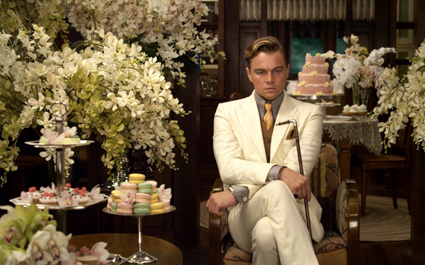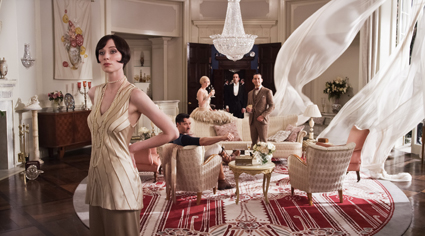 |
Leonardo DiCaprio, The Great Gatsby |
But ever hopeful that Luhrmann and production designer Catherine Martin would repeat the visually thrilling experience of Romeo + Juliet (1996), I was willing to take my chances. Maybe my sanguine companion (a literary type) was anticipating an intelligent and nuanced adaptation of F Scott Fitzgerald’s delicate story of hope, loss and the fading American Dream. But not me. I was expecting spectacle—glitz and bling as someone else put it. I went for the costumes. I went for the fashion. The film has an excess of both. So why the disappointment?
Let’s start with the costumes. After an afternoon spent at the popular Hollywood Costume exhibition at ACMI, I didn’t need to be reminded that costume design involves the creativity and hard work of many talented individuals. In the complex process of getting a script to the screen, nothing is left to chance; everything matters. In this, The Great Gatsby is no exception, and if ACMI were to put all of the film’s spectacular costumes on show I have no doubt that they too would draw murmurs of admiration from the visiting crowds.
But if you’d read all the curator’s notes and watched all the interviews with the designers, actors and directors, you would know that the ACMI exhibition has one take-home message: the most important function of costume design is not to provide spectacle, but to transform the actor into a character we can believe in. In other words, what we are supposed to see up on the screen is not an actor dressed in a costume, but simply someone wearing clothes. If we buy this fiction, then the film can concentrate on the narrative and we can sit back and enjoy the story.
Of course, if the actor happens to be playing Elizabeth I, Marie-Antoinette or Daisy Buchanan, a certain degree of spectacle is required. But even costumes that dazzle can serve the narrative by revealing the psychological state of a character—the exterior shell of costume, if you like, is innermost feelings turned inside-out. Think for example, of those scenes where a character tries on numerous outfits in an attempt to find one that is ‘just right’—a Goldilocks-style trope that, often as not, combines fashion spectacle with a final choice that, in costume terms, is the perfect psychological ‘fit.’ When it comes to The Great Gatsby, Fitzgerald helps out by describing what his characters are wearing; the film cherry-picks these clues and then fills in the gaps.
So we get Carey Mulligan’s Daisy, America’s version of an aristocrat, wistful and romantic in pastel confections. At Gatsby’s party, wearing a Prada-designed stole that frames her delicate features in a lilac haze of fur, she is seductively vulnerable—but also trapped prey, an image that reinforces Gatsby’s vision of her as something rare and precious. Gatsby himself is appropriately obsessive about his appearance, everything is hand-finished, everything perfect. His fondness for ‘brands’ (“My man in England sends things over”), his compulsive expenditure (that extraordinary shirt scene), and his conspicuous display of wealth all betray a character that is clearly nouveau riche.
 |
The Great Gatsby |
The same broad brushstrokes are applied to the party scenes, those lavish spectacles that form the backdrop to much of the action. Fitzgerald coined the term “The Jazz Age” and Luhrmann’s film fills the screen with everything we have come to expect of the era, as well as adding a mass of pop culture clichés from our own. The effect is a mash-up of frenzied kineticism. “It’s not too much, is it?” asks Gatsby. Obligingly, Nick shakes his head.
But it is. I love this sort of stuff and want these scenes to work. Film is made for these moments and it’s not hard to imagine that Gatsby’s parties were designed to resemble a euphoric explosion from one of those cannon-sized bottles of Moët that keep turning up in the film. Every shimmying guest, kiss-curled dancer and spangled entertainer a gorgeous sparkling droplet, cascading across the screen in a glorious celebration of wealth, beauty and excess. Instead, the spinning dizziness is nauseating and all the intricate elements of design are lost, merging into one mass. A kaleidoscopic vomit of confetti, streamers and glitter.
Perhaps I wouldn’t have minded so much if Luhrmann had managed to make it all mean something, if he hadn’t made the mistake of confusing excess with decadence, if he hadn’t made it all look like such good, clean fun. Where are the consequences? Where are the torn dresses, the shredded hearts and the trainwrecked souls that are scattered throughout the novel? Colin McDowell is right to compare the film to a fashion magazine; youth, sex, money, image—like the glossy pages of Vogue, the film has it all. But he is right for the wrong reasons. Despite the collaboration with Prada and the commercial tie-ins with Tiffany’s, Brooks Brothers, Fogal and so on; despite costumes that could walk straight from the cineplex to the retail store, the problem with the presence of fashion in this film is not that there is too much, but that there is too little. Let me clarify.
What fashion can do, what fashion offers a film like The Great Gatsby, is an immediate entrée into a gilt-edged world. Not without reason, fashion has a reputation as obsessively preoccupied with surface and appearance; it is superficial, frivolous and fickle—all traits that play precisely into Fitzgerald’s depiction of hard, cut-glass characters, those “careless people” who casually abandon people and things. Instinctively, Luhrmann gets this. But whereas Fitzgerald knows the value of the shadow side of style to the telling of his tale, Luhrmann can’t help turning back towards the light.
Baz, it has been suggested, doesn’t ‘do’ darkness. Fashion is not so squeamish; the best fashion imagery understands that the flip side of glamour is death. In ignoring the dual nature of fashion, by keeping it one-dimensional, or at best as a cipher, Luhrmann misses the chance to corral his considerable talent for spectacle into a film that would have been worthy of Fitzgerald’s novel. If Luhrmann had got the costume, spectacle and fashion right, then perhaps he might have also got right Fitzgerald’s depiction of the Janus-faced coin of the American Dream. Where the author gives us a mirror, the filmmaker gives us… nothing.
Karen de Perthuis writes about fashion, teaches fashion theory at UTS and design at UWS and has been a costume designer and stylist for the film and television industry
RealTime issue #117 Oct-Nov 2013 pg. 15
© Karen de Perthuis; for permission to reproduce apply to [email protected]








 back
back